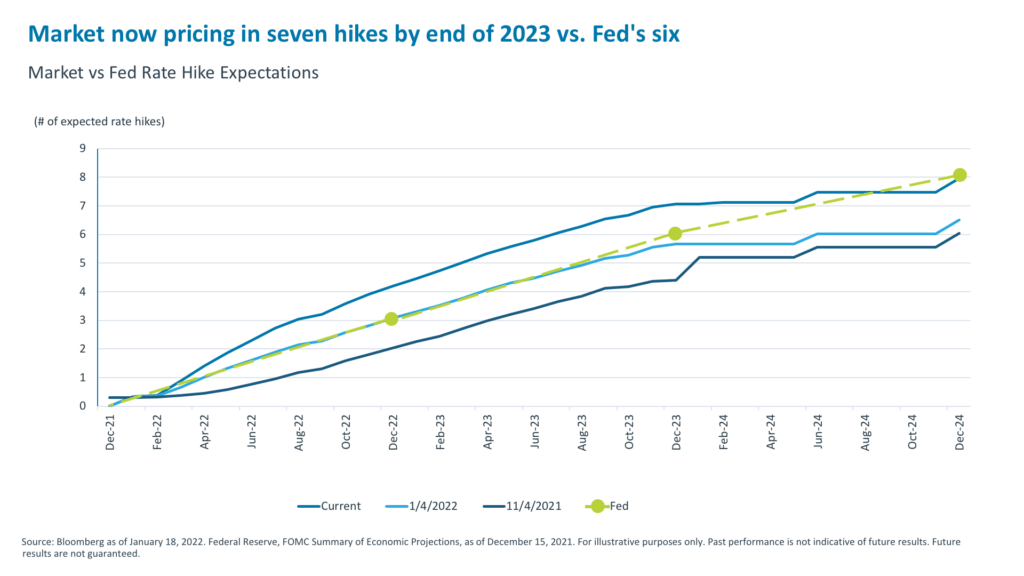Consistent with history, the upward movement in ten-year U.S. Treasury yields – rising 50bps in just over a month – has caused a pullback in equities, particularly high-flying growth stocks.
But history also tells us that this will not last forever. Once markets have appropriately priced in the future path of Federal Reserve (Fed) policy, the ten-year U.S. Treasury yield approaches fair value, and valuations have reset sufficiently, markets should regain their footing. For example, during the so-called taper tantrum in 2013, the S&P 500 fell 6% from mid-May to mid-June, but rebounded to above the May highs by mid-July.1 Today, I believe we are close to satisfying those conditions.
1) The markets have nearly priced in close to seven 25bp rate hikes (+1.75%) by the end of 2023, above the Fed’s latest projections of 6 hikes.
 2) At 1.82%, the ten-year Treasury yield is approaching fair value, which is estimated at 1.81%-1.86%.2 Of course, we would expect the yield to move higher still as the Fed hikes rates over the coming quarters but in the near term a lot seems to have been priced in.
2) At 1.82%, the ten-year Treasury yield is approaching fair value, which is estimated at 1.81%-1.86%.2 Of course, we would expect the yield to move higher still as the Fed hikes rates over the coming quarters but in the near term a lot seems to have been priced in.
3) Equity valuations have reset significantly lower. For example, software enterprise value-to-sales valuations have fallen from 17x to 10x over the last month.3 By some measures, according to Bank of America, fund managers are now more underweight technology stocks than they have been since 2008.4 Hedge funds have also drastically reduced allocations to tech.5
It is interesting to note that market volatility has remained subdued despite the sell-off in high multiple stocks. However, volatility has spiked this week and could remain heightened ahead of next week’s Federal Open Market Committee (FOMC) meeting.
The opportunity around the FOMC meeting
For sure, the FOMC meeting is important. Investors might be unwilling to materially step in to buy the market and/or the pullback in tech until this event risk is cleared. This meeting is a chance for the Fed to shape and clarify the narrative on rates.
Rate hikes are needed to first and foremost slow inflation while seeking to moderate but not derail economic growth. But it is also true that, if left unchecked, inflation may have hit growth anyway. After all, the biggest concerns right now for companies are rising labor costs and inflationary pressures, which may be starting to weigh on margins and profitability. It may therefore be smart for the Fed to act decisively to help ease inflation running at 7%.6 If they do, given the significant repricing we have already had, rate hikes might end up being a net positive for the economy and help prolong this earnings cycle.
Expect some turbulence in the meantime
Another lesson from history is that the three months before and after the first rate hike in a cycle tend to be a choppy period for markets.
 Markets do not tend to move much over those time periods, but there have been distinct factor rotations. Low valuations stocks have performed better than high valuations stocks both before and after a hiking cycle starts.7 Dividend-yielding stocks do a better job at protecting against volatility and offering yield in the meantime.8 Accordingly, our strategy for the next quarter is this:
Markets do not tend to move much over those time periods, but there have been distinct factor rotations. Low valuations stocks have performed better than high valuations stocks both before and after a hiking cycle starts.7 Dividend-yielding stocks do a better job at protecting against volatility and offering yield in the meantime.8 Accordingly, our strategy for the next quarter is this:
1) Add dividend-yielding stocks (energy, pharmaceuticals, financials, and real estate) and get paid to wait out the choppiness. We also favor private credit and real estate, which have performed well in inflationary and rising rate environments (discussed in greater detail in our 2022 Outlook).9
2) Use the pullback in the first quarter to add to reasonably priced tech (more on this below) especially as the cyclical momentum in interest-rate sensitive industries may slow as the Fed starts to hike rates.
3) Position for strong re-opening momentum in the second quarter. A lot of travel has been deferred from the first quarter, and there is a great deal of pent-up corporate demand for group meetings and client visits. We prefer airlines to hotels.
Time to buy the dip in software
To point number 2 above, there is value to be found in certain tech sectors after the recent pullback.
The overall forward price-to-earnings ratio of technology stocks fell from over 30x to 25x now, returning to levels last seen in May 2020.10 Within that, software valuations have corrected particularly sharply, but in many cases company fundamentals and growth rates remain stronger than the broader market.11 Also, in an environment with rising costs and concerns about margin compression, we note that software stocks have some of the most attractive and persistent margins.12 Finally, IT spending on software is forecast to grow 11% in 2022, twice the rate of overall IT spend.13 Many software companies are experiencing sales growth exceeding 20%.14
Software is therefore now trading at much more attractive valuations, and we would suggest taking advantage of lower prices in the first quarter to add exposure, specifically to companies benefitting from the next stage of digital transformation and its critical components. This includes Artificial Intelligence, Metaverse, and Cybersecurity.
1. Bloomberg, January 18, 2022
2. JPMorgan Rates Strategy, January 14, 2022
3. Company reports, J.P. Morgan estimates, Bloomberg, as of January 3, 2022.
4. Bank of America, Global Fund Manager Survey, January 18, 2022
5. Goldman Sachs, Prime Services Weekly, January 14, 2022
6. US Bureau of Labor Statistics, Bloomberg, as of January 17, 2022.
7. Goldman Sachs Global Investment Research.
8. Ibid
9. BlackRock, “Inflation and Real Assets”, July 2021. Adams Street, “Private Credit Update: Resilience and Opportunity When Facing Inflation”, September 2021.
10. Bloomberg, as of January 18, 2022.
11. Company reports, J.P. Morgan estimates, Bloomberg, as of January 3, 2022.
12. Goldman Sachs Investment Research, 2018.
13. Gartner, Worldwide IT Spending Forecast, January 18, 2022.
14. Bloomberg, as of January 18, 2022.
IMPORTANT INFORMATION
The material herein has been provided to you for informational purposes only by iCapital, Inc. (“iCapital”). This material is the property of iCapital and may not be shared without the written permission of iCapital. No part of this material may be reproduced in any form, or referred to in any other publication, without express written permission of iCapital.
This material is provided for informational purposes only and is not intended as, and may not be relied on in any manner as, legal, tax or investment advice, a recommendation, or as an offer to sell, a solicitation of an offer to purchase or a recommendation of any interest in any fund or security. You should consult your personal accounting, tax and legal advisors to understand the implications of any investment specific to your personal financial situation. This material does not intend to address the financial objectives, situation or specific needs of any individual investor. Alternative investments are complex, speculative investment vehicles and are not suitable for all investors.
The information contained herein is an opinion only, as of the date indicated, and should not be relied upon as the only important information available. Any prediction, projection or forecast on the economy, stock market, bond market or the economic trends of the markets is not necessarily indicative of the future or likely performance. The information contained herein is subject to change, incomplete, and may include information and/or data obtained from third party sources that iCapital believes, but does not guarantee, to be accurate. iCapital considers this third-party data reliable, but does not represent that it is accurate, complete and/or up to date, and it should not be relied on as such. iCapital makes no representation as to the accuracy or completeness of this material and accepts no liability for losses arising from the use of the material presented. No representation or warranty is made by iCapital as to the reasonableness or completeness of such forward-looking statements or to any other financial information contained herein.
Securities products and services are offered by iCapital Markets, an SEC-registered broker-dealer, member FINRA and SIPC, and an affiliate of iCapital, Inc. and Institutional Capital Network, Inc. These registrations and memberships in no way imply that the SEC, FINRA, or SIPC have endorsed any of the entities, products, or services discussed herein. Annuities and insurance services are provided by iCapital Annuities and Insurance Services LLC, an affiliate of iCapital, Inc. “iCapital” and “iCapital Network” are registered trademarks of Institutional Capital Network, Inc. Additional information is available upon request.
© 2023 Institutional Capital Network, Inc. All Rights Reserved.

















